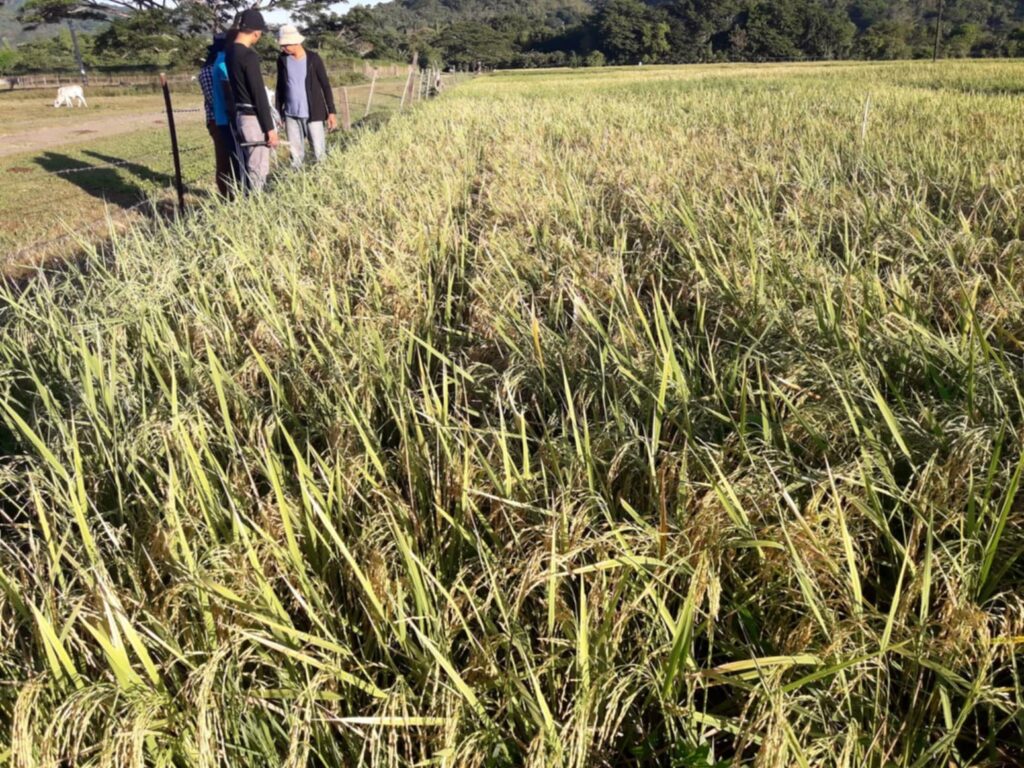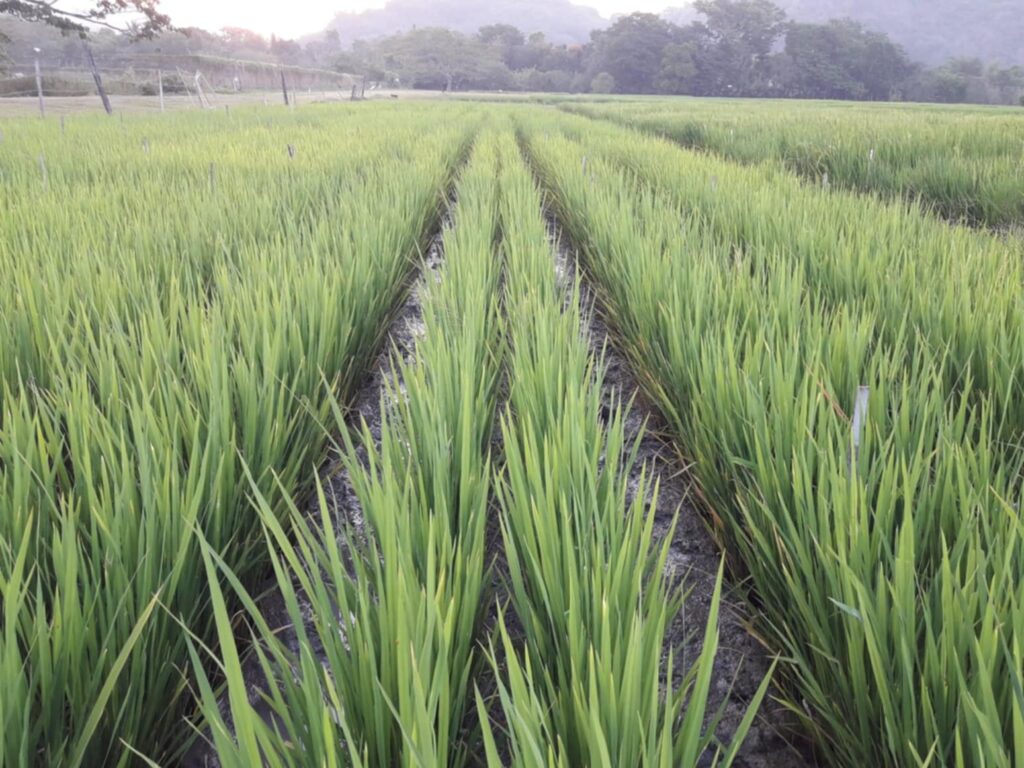Hybrid rice plants at the maturity stage, nearing harvest, are displayed in a research field at the University of the Philippines Los Baos. (Photo courtesy of Dr. Ted Mendoza) LOS BAOS, PhilippinesThe Philippines is on a path to self-sufficiency in...

Hybrid rice plants at the maturity stage, nearing harvest, are displayed in a research field at the University of the Philippines Los Baños. (Photo courtesy of Dr. Ted Mendoza)
LOS BAÑOS, Philippines—The Philippines is on a path to self-sufficiency in rice production, with hybrid rice genotypes emerging as a critical innovation. As one of the world’s top 10 rice producers but also one of its largest importers, the nation faces the challenge of balancing its growing population and rising consumption with limited arable land.
Rice, a staple food for Filipinos, accounts for 45% to 70% of daily calorie intake. However, current production levels of 12.86 million metric tons annually fall short of the demand of 16 million metric tons, resulting in a persistent supply deficit. Research by Dr. Teodoro Mendoza outlines an innovative pathway toward addressing this issue: hybrid rice genotypes and the System of Rice Intensification (SRI).
Article continues after this advertisement Innovations in rice productionHybrid rice, developed through genetic improvements combining high-yield and resilient varieties, significantly outperforms traditional inbred rice genotypes. While inbred varieties yield 5 to 6 tons per hectare, hybrids produce 8 to 12 tons. Under optimal conditions, some hybrids have reached yields as high as 22 tons per hectare.
FEATURED STORIES BUSINESS Buying gold can be this affordable BUSINESS PH remains heavily reliant on imported vehicles BUSINESS How hybrid rice can feed the PhilippinesAdditionally, SRI, introduced in the 1980s, promises to maximize yields while reducing inputs such as seeds, fertilizers, and water. SRI-grown hybrids have demonstrated up to 61% higher yields compared to conventionally grown inbreds, showcasing the potential of sustainable farming practices.
Dr. Mendoza and his team’s studies highlight the potential of combining hybrid rice with SRI techniques to address key challenges in rice farming. For instance, under semi-organic farming systems, hybrids planted with SRI methods achieved significant yield gains while reducing reliance on chemical fertilizers.
Article continues after this advertisement Challenges to hybrid adoptionDespite their promise, hybrid seeds are costly at P400 per kilogram—up to 100 times more expensive than inbred seeds priced at P40 per kilogram. Farmers are also concerned about hybrids requiring higher agrochemical inputs and the risks posed by climate change, particularly typhoons, which can devastate crops.
Article continues after this advertisementThese issues underscore the need for localized hybrid seed production, supported by institutions like the Philippine Rice Research Institute (PhilRice), and adjusted planting schedules. For wet-season crops, planting should be done early—between mid-May and the first week of June—so rice can be harvested in late August to early September, avoiding the heavy rains and typhoons of October and November. Dry-season crops should be planted after Christmas to the first week of January.
Article continues after this advertisementThe National Irrigation Administration (NIA) must align water release schedules with these adjusted planting timelines, and alternative irrigation systems should be established for areas outside NIA service zones.
Studies at the University of the Philippines Los Baños (UPLB) explored integrating hybrids with organic and semi-organic farming systems. Results showed that hybrids grown under SRI with reduced inputs—80% fewer seeds (4.0 kilograms per hectare), 50% less synthetic fertilizer, and no pesticides—yielded superior results, significantly lowering costs while maintaining productivity and increasing farmers’ income.
Article continues after this advertisement

Hybrid rice plants in the panicle formation stage, observed in a research field at UPLB. (Photo courtesy of Dr. Ted Mendoza)
A roadmap to self-sufficiencyThe team proposes two scenarios to achieve rice self-sufficiency by 2050. The first scenario involves expanding hybrid cultivation to 2 million hectares while maintaining 2.8 million hectares of inbred rice. Hybrid rice yields of at least 6 tons per hectare—though many farmers already achieve 8 tons or more—were used for scenario building, alongside a 4-ton yield for inbreds.
In addition to increasing yields, reducing per capita rice consumption from 140 kilograms to 110 kilograms and stabilizing population growth through family planning initiatives are recommended strategies. These combined efforts could ensure rice self-sufficiency until 2050.
Beyond rice: A holistic approachExperts advocate for diversified caloric sources and improved agricultural practices to reduce dependency on rice. Agroecological farming, which incorporates organic inputs and ecological pest management, could also enhance climate resilience and sustainability.
Subscribe to our daily newsletter
The hybrid rice innovation pathway offers a viable solution to the Philippines’ rice crisis. However, achieving this goal requires addressing high seed costs, investing in sustainable farming systems, stabilizing farm gate palay prices, and fostering a shift in consumption patterns to include more vegetables and fruits. As Dr. Mendoza’s research underscoresmega swerte, with strategic interventions, the country can turn its rice fields into engines of food security and prosperity.
[Editor’s Note: Dr. Teodoro C. Mendoza, a retired crop science professor at UPLB and multi-awarded UP Scientist, is currently the Science Director of the Community Legal Help and Public Interest Center. His team includes Mae Soe Oo and Isaac Sulonteh Flom, his former master’s students from Myanmar and Liberia, respectively.] READ NEXT First Gen secures LNG supply from Shell Eastern Vivant bags 15-year power supply deal for Palawan EDITORS' PICK Mary Jane Veloso’s ma fears for daughter’s life once back in PH NBA: Celtics end Cavaliers’ 15-0 start An emotional Rafael Nadal retires after Davis Cup exit Aegis calls for respect for the late Mercy Sunot, slams talk of ‘bad habit’ PH business registrations, renewals hit record high Tim Cone says 2024 is Gilas Pilipinas’ ‘trial year’ MOST READ SC declares null and void Guanzon's substitution for P3PWD party-list VP Duterte laments Mindanao Railway Project's delayed construction Solon: OVP, DepEd release of CF to various areas daily is impossible House probe: OVP, DepEd CFs received by same man, different signatures Follow @FMangosingINQ on Twitter --> View comments